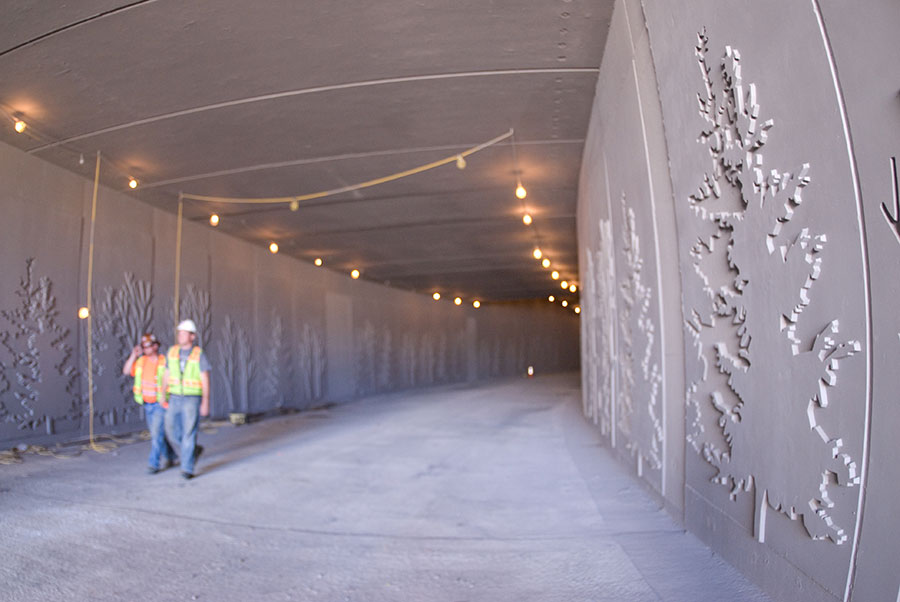Tunnels and underground structures, like subways, basements, and underground parking lots, are essential for modern infrastructure. However, they face unique challenges, including water seepage, moisture buildup, and pressure from groundwater. Waterproofing these structures is crucial to ensure their safety, durability, and functionality. In this article, we will explain the importance, methods, and benefits of tunnel and underground structure waterproofing in simple sentences.
What Is Tunnel and Underground Structure Waterproofing?
Waterproofing tunnels and underground structures involves sealing their surfaces to prevent water and moisture from entering. Special materials and techniques are used to create a protective barrier that stops water from causing damage. This process is important for keeping these structures strong, safe, and operational.
Why Is Waterproofing Necessary for Tunnels and Underground Structures?
- Prevents Water Seepage:
- Underground structures are often exposed to groundwater and rain.
- Waterproofing stops water from seeping into these areas.
- Protects the Structure:
- Water can weaken concrete and corrode steel reinforcements.
- Waterproofing prevents structural damage and ensures longevity.
- Avoids Mold and Mildew:
- Damp conditions encourage the growth of mold and mildew.
- Waterproofing keeps the structure dry, preventing health hazards.
- Enhances Safety:
- Water buildup can cause slippery surfaces and electrical hazards.
- Waterproofing improves the safety of tunnels and underground areas.
- Increases Lifespan:
- A well-waterproofed structure lasts longer and requires fewer repairs.
- This reduces maintenance costs and ensures uninterrupted use.
- Prevents Groundwater Contamination:
- Waterproofing stops harmful chemicals from leaking into groundwater systems.
Common Problems Fixed by Waterproofing
- Leaks and Seepage:
- Waterproofing seals cracks and joints to stop water from entering.
- Water Pressure Damage:
- Hydrostatic pressure from groundwater can damage walls and floors.
- Waterproofing creates a barrier to resist this pressure.
- Corrosion of Reinforcements:
- Waterproofing protects steel and other metal reinforcements from rust.
- Cracks in Concrete:
- It fills and seals cracks to prevent water from entering and causing further damage.
- Efflorescence:
- Waterproofing eliminates white, powdery deposits caused by water in concrete.
Types of Waterproofing for Tunnels and Underground Structures
- Membrane Waterproofing:
- Waterproof membranes, often made of rubber or plastic, are applied to the surface.
- These membranes are durable and provide excellent protection.
- Cementitious Waterproofing:
- Cement-based coatings are used to seal concrete surfaces.
- This method is simple, cost-effective, and commonly used in underground structures.
- Liquid Waterproofing:
- Liquid waterproofing materials, such as polyurethane, are applied to the surface.
- They form a seamless and flexible waterproof layer after drying.
- Injection Waterproofing:
- Waterproofing materials are injected into cracks, joints, and voids.
- This method is effective for repairing existing leaks.
- Bituminous Waterproofing:
- Bitumen-based coatings are applied to create a strong waterproof layer.
- This method is long-lasting and resistant to water.
- Sheet Waterproofing:
- Pre-fabricated waterproof sheets are installed over surfaces.
- These sheets are reliable and provide long-term protection.
Steps in Tunnel and Underground Structure Waterproofing
- Inspection:
- Professionals inspect the structure to identify cracks, leaks, and weak points.
- Surface Preparation:
- The surface is cleaned to remove dirt, dust, and debris.
- Cracks and joints are repaired to ensure a smooth surface.
- Application of Waterproofing Material:
- The chosen waterproofing material is applied using specialized techniques.
- Multiple layers may be added for better protection.
- Sealing Joints and Gaps:
- Joints and gaps are sealed with waterproof sealants or injections.
- Drainage Installation:
- Drainage systems are installed to redirect water away from the structure.
- Testing:
- The waterproofing is tested to ensure there are no leaks or weak spots.
Key Challenges in Waterproofing Tunnels and Underground Structures
- High Water Pressure: Groundwater exerts pressure on underground structures, making waterproofing challenging.
- Complex Shapes and Designs: Tunnels and underground structures often have irregular shapes, requiring precise waterproofing techniques.
- Temperature and Weather Changes: Extreme temperature changes can cause materials to expand or contract, affecting waterproofing.
- Accessibility Issues: Reaching certain areas of tunnels and underground structures for waterproofing can be difficult.
Benefits of Tunnel and Underground Structure Waterproofing
- Enhanced Durability: Waterproofing protects the structure from damage and increases its lifespan.
- Improved Safety: Dry tunnels and underground spaces are safer for users and workers.
- Cost Savings: Preventing water damage reduces the need for expensive repairs and maintenance.
- Environmental Protection: Waterproofing prevents chemicals and pollutants from contaminating groundwater.
- Better Functionality: Waterproofed tunnels and underground spaces remain functional even during heavy rains or floods.
- Aesthetics: Waterproofing prevents stains, efflorescence, and other visual damage caused by water.
DIY Waterproofing: Is It Possible?
Waterproofing tunnels and underground structures is a highly specialized task that requires professional expertise. It is not suitable for DIY projects due to the complexity of the work and the need for advanced tools and materials. Hiring professionals ensures the job is done correctly and efficiently, providing long-lasting results.
Cost of Tunnel and Underground Structure Waterproofing Services
The cost of waterproofing services depends on:
- The size and complexity of the structure.
- The type of waterproofing method used.
- The extent of existing water damage.
- Labor charges and material costs.
Although the initial cost may be high, waterproofing is a long-term investment that saves money by preventing damage and repairs.
Choosing the Right Waterproofing Service
- Experience: Look for professionals with experience in waterproofing tunnels and underground structures. 3M Waterproofing has 11 year waterproofing service experience.
- High-Quality Materials: Ensure they use durable and reliable waterproofing materials.
- Affordable Pricing: Compare prices and select a service that offers good value for money.
- Warranty: Choose a provider that offers a warranty for their work. Get a reliable waterproofing solution with 12 months warranty from 3M Waterproofing.
- Customer Reviews: Read reviews or get recommendations to find a trustworthy company.
Conclusion
Tunnel and underground structure waterproofing is a critical service that protects these essential parts of modern infrastructure. It prevents water damage, enhances safety, and ensures the long-term durability of tunnels, subways, basements, and other underground spaces. By hiring experienced professionals and choosing the right waterproofing methods, you can safeguard these structures and enjoy peace of mind. Waterproofing is not just a technical task—it is an investment in the safety, functionality, and value of the built environment.

